எல்லா டீக்கடைகளிலும் தவறாமல் காணப்படும் ஒரு நொறுக்குத்தீனி, சமோசா. `மூணு பத்து ரூபா’ என குட்டியூண்டு சைஸில் பேப்பர் கவரில் விற்கப்படுவது தொடங்கி, உள்ளங்கைகொள்ளாத சைஸ் வரை விதவிதமான வகைகள் உண்டு. சினிமா தியேட்டர்களில் இடைவேளையில் சமோசா கடித்து, டீ குடிக்காத தமிழ் ரசிகர்கள் வெகு குறைவு. மதுரைப் பக்கம் வெதுவெதுப்பான சூட்டில் வெங்காய மசாலா வைத்துப் பரிமாறப்படும் `சமோசா’, அலாதிச் சுவைகொண்டது. சென்னை சௌகார்பேட்டை பகுதியில் மொறுமொறு சுவையுடன் பச்சைச் சட்னி, சாஸுடன் கிடைக்கும் வட இந்திய வகைக்கு, பிரத்யேக ரசிகர்கள் இருக்கிறார்கள். சென்னையில் பல இடங்களில் சமோசா-சுண்டல் காம்பினேஷனுக்கு மயங்கிக்கிடக்கிறவர்கள் உண்டு. `எல்லாம் சரி... இது, நம் உடலுக்கு நல்லதுதானா?’ என்கிற கேள்வியையும் கூடவே கேட்கவேண்டியிருக்கிறது.
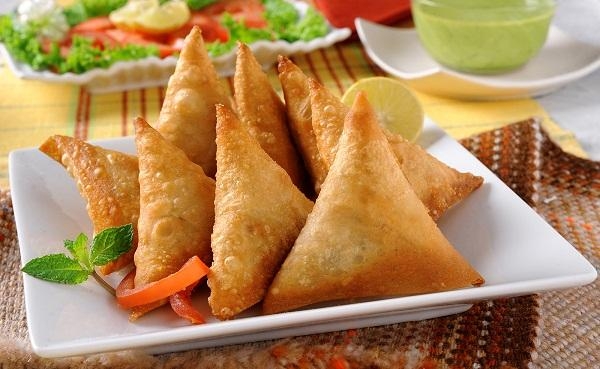
‘சமோசாவும் நம் ஆரோக்கியமும்’ என்கிற பக்கத்துக்குப் போவதற்கு முன்னால், இதன் வரலாற்றை மேம்போக்காக ஒரு புரட்டுப் புரட்டிவிடலாம். `சமோசா’, மட்டுமல்ல... ஒவ்வொரு நாட்டிலும், ஒவ்வொரு பகுதியிலும் அழைக்கப்படும் இதன் பெயர், மலைப்பைத் தருகிறது. சமஸ்கிருதத்தில், `கட்டக்கா’, பெங்காலியில் `ஷிங்காரா’, உஸ்பெஸ்கிஸ்தானில் `சொம்சா’, அரபியில் `சம்புசாக்’, பர்மிய மொழியில் `சமோஷா’!
சப்பாத்திக்கு இடுவது மாதிரி, கோதுமை மாவை (மைதாவும் இப்போது சேர்க்கப்படுகிறது) இட்டு, அதில் மசாலா வைத்து முக்கோணமாக மடித்துப் பொரித்து எடுத்தால், அது சமோசா. சைவம் எனில் மசாலாவில் வேகவைத்த உருளைக்கிழங்கு, பட்டாணி, பச்சைமிளகாய், வெங்காயம், இன்னும் சில வாசனைப் பொருள்கள் கலந்தும் மசாலா தயாரிக்கிறார்கள். அசைவம் எனில், இறைச்சியில் செய்யப்பட்ட மசாலா! இந்தியாவில் பெரும்பாலும் சைவ சமோசாதான் புழக்கத்தில் இருக்கிறது.
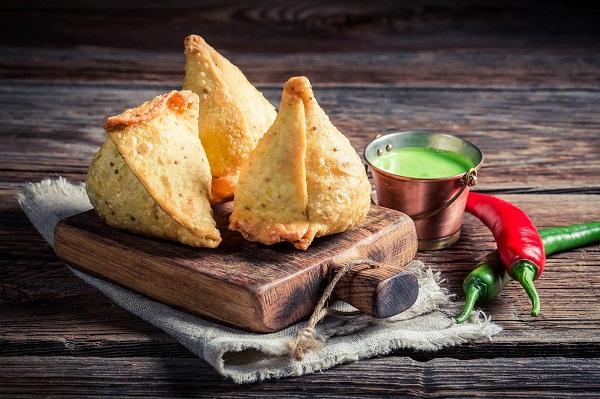
கடந்த எட்டு நூற்றாண்டுகளாக தெற்காசிய சமையலில் சமோசா வெகு பிரபலம். என்றாலும், `இதன் பூர்வீகம் எது?’ என்றால், மத்தியக் கிழக்கு நாடுகளைத்தான் காட்டுகிறார்கள் வரலாற்று ஆசிரியர்கள். ஈரானிய வரலாற்றியலாளர் அபுல்ஃபாஸல் பேஹாக் (Abulfazl Beyhaqi), `தாரிக்-ஏ பேஹாக்’ (Tariq-e Beyhaqi) என்ற வரலாற்று நூலில், 10-ம் நூற்றாண்டுக்கு முன்னரே சமோசா இருந்ததைக் குறிப்பிட்டிருக்கிறார். 13, 14-ம் நூற்றாண்டில்தான் வியாபாரிகள் மூலமாக இந்தியாவுக்குள் மூக்கை நுழைத்திருக்கிறது சமோசா. அப்படி அல்ல... டெல்லி சுல்தான்களுக்காக சமைக்க வந்த மத்திய கிழக்கு மற்றும் மத்திய ஆசிய நாடுகளைச் சேர்ந்த சமையல்காரர்கள்தான் இதை அறிமுகப்படுத்தினார்கள் என்றும் சொல்கிறார்கள்.
டெல்லி சுல்தான்கள் சபையில் இருந்த அரசவைக் கவிஞர் அமிர் குஸ்ரோ (Amir Khusro), உலகைச் சுற்றிவந்த யாத்ரீகர் இபின் பதூதா (Ibn Battuta)... எனப் பலரும் சமோசா பற்றிய குறிப்பை எழுதிவைத்துவிட்டுச் சென்றிருக்கிறார்கள். முகமது பின் துக்ளக்கின் அரண்மனைச் சமையலில் சமோசாவுக்கும் இடம் இருந்ததாகச் சொல்கிறார் இபின் பதூதா.
ஆரம்பத்தில் படைவீரர்கள், வியாபாரிகள், ஊர் ஊராகப் பயணம் செய்கிறவர்கள் இரவில் தங்க நேரிடும்போது, சமோசாக்களை செய்து வைத்துக்கொள்வார்களாம். அடுத்த நாளில் பகல் உணவுக்கு உபயோகப்படும் என்பதற்காக இந்த ஏற்பாடு. அரசர்கள், சுல்தான்களுக்கு மட்டுமல்ல... சாமான்யர்களுக்கும் பிடித்த நொறுக்குத்தீனி சமோசா. இந்தியாவில் இது அறிமுகமானபோது, உத்தரப்பிரதேச மாநில மக்கள், அதை சைவ வடிவத்துக்கு மாற்றி ஏற்றுக்கொண்டார்கள். சில நூற்றாண்டுகளிலேயே சமோசா இந்தியாவில் பிரபலமாகிவிட்டது. வட இந்தியாவில் சமோசா மாவுக்குப் பெரும்பாலும் மைதாவைத்தான் பயன்படுத்துகிறார்கள்.
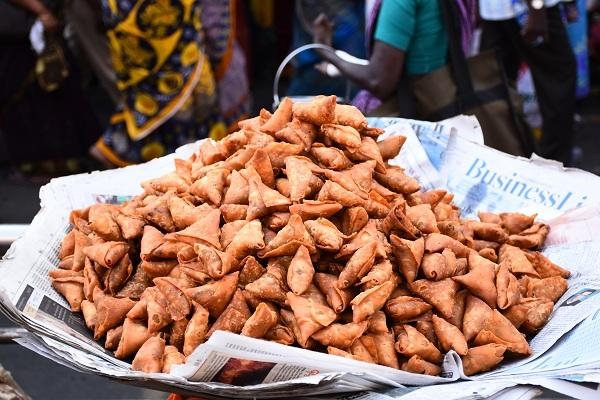
வட இந்தியாவில் சில நகரங்களிலும் பாகிஸ்தானிலும் அசைவ சமோசா வெகு பிரபலம். ஆடு, மாடு, கோழி இறைச்சிகளை ஸ்டஃபிங்கில் சேர்க்கிறார்கள். பஞ்சாப்பில் சமோசாவுடன் சென்னா பரிமாறப்படுகிறது. மும்பையில், `சமோசா பாவ்’ பிரசித்திபெற்ற ஒன்று. பன்னில் வைத்துத் தரப்படும் இதை `இந்தியன் பர்கர்’ என்றுகூடச் சொல்லலாம். தீபாவளிப் பண்டிகையின்போது வட இந்தியாவில் சில இடங்களில் இனிப்பு சமோசா தயாரித்து, பரிமாறும் வழக்கம் இன்றைக்கும் இருக்கிறது.
ஆப்பிரிக்கா, எத்தியோப்பியா, சோமாலியா உள்ளிட்ட நாடுகளில் சமோசா, பண்டிகைகால ஸ்பெஷல் ரெசிப்பி. பொரித்துச் சாப்பிட்டால் உடலுக்குத் தீங்கு என்பதற்காக சில மேற்கத்திய நாடுகளில் சமோசாவை மைக்ரோவேவ் அவனில் பேக் செய்ய ஆரம்பித்திருக்கிறார்கள். ஸ்டஃபிங்குக்கு ஆரோக்கியமான காய்கறிகள்! உலகமெங்கும் பிரபலான உணவுப்பொருளாகிவிட்டது சமோசா... ஒவ்வோர் இடத்திலும் ஒரு சுவை. சுவைத்து மகிழலாம்தான். அதற்கு முன்னர், `சமோசா ஆரோக்கியமானதுதானா?’ என்ற கேள்விக்கு டயட்டீஷியன் சௌமியா சொல்லும் விளக்கத்தையும் பார்த்துவிடுவோம்...
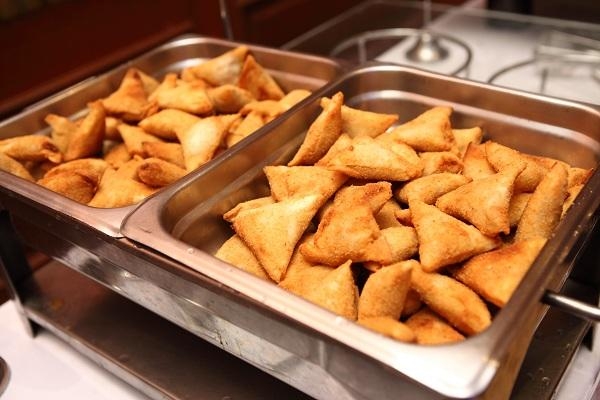
``மாலை 4 மணி. டீ குடிக்கப் போகிற இடத்தில் தட்டில் சுடச்சுட கொட்டிவைக்கப்பட்டிருக்கிறது சமோசா. ஒன்றை எடுத்துக் கடித்துச் சுவைக்க வேட்கை எழும்தான். ஆனால், அதனால் ஏற்படும் சில பக்கவிளைவுகளைத் தெரிந்துகொண்டால், அதன் பக்கம் போக மாட்டீர்கள்.
ஒரு சின்ன சமோசாவில் 240 கலோரிகள் இருக்கின்றன. நம் உள்ளூர் கடைகளில் விற்கப்படும் சமோசாக்களில் ஊட்டச்சத்தைத் தரக்கூடிய பொருட்கள் கிட்டத்தட்ட இல்லை என்றே சொல்லலாம். சர்க்கரைநோயாளிகளுக்குச் சேராத உருளைக்கிழங்கு இருக்கிறது; அதற்கான மாவில் நம் உடலுக்குத் தீங்கு விளைவிக்கும் மைதா கலக்கப்படுகிறது. மைதாவில் இருக்கும் அதிக அளவிலான கிளைசெமிக் இண்டெக்ஸ் ரத்தத்தில் சர்க்கரையின் அளவைக் கூட்டும். கொழுப்பை அதிகரிக்கச் செய்யும். இதுகூடப் பரவாயில்லை. சமோசாவைப் பொரிக்கப் பயன்படுத்தப்படும் எண்ணெய்... அதுதான் ஆபத்தானது.
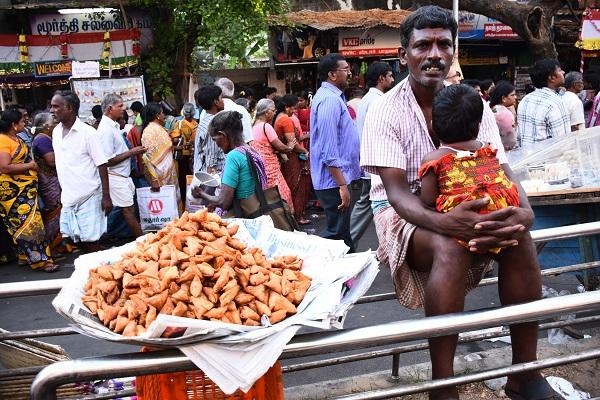
தெருவோரக் கடைகளில் சமோசா பொரிக்க எந்த வகை எண்ணெயைப் பயன்படுத்துகிறார்கள் என்பது நமக்குத் தெரியாது. அதேபோல ஒரே எண்ணெயில் திரும்பத் திரும்ப பொரிப்பார்கள். அது ட்ரான்ஸ் ஃபேட்டுக்கு (Trans fat) வழிவகுக்கும். இதை `ஹைட்ரோஜனேஷன்’ (Hydrogenation) என்பார்கள். அதாவது ஒரு உணவைத் திரும்பத் திரும்ப சூடுபடுத்தும்போதோ, ஒரே எண்ணெயை மேலும் மேலும் பயன்படுத்தும்போதோ ஹைட்ரஜன் உணவோடு சேரும். இது ட்ரான்ஸ்ஃபேட்டுக்கு வழிவகுக்கும். சர்க்கரைநோயாளிகளும், உயர் ரத்த அழுத்தம் உள்ளவர்களும் இதைச் சாப்பிட்டால் கட்டுப்படுத்த முடியாத அளவுக்கு அவர்களின் பிரச்னை தீவிரமாகும்.
மற்ற ஸ்நாக்ஸைவிட சமோசா கொஞ்சம் டேஞ்சர்தான். அதீத கொலஸ்ட்ரால், செரிமானக் கோளாறுகள், ட்ரான்ஸ் ஃபேட் (கெட்ட கொழுப்பு), சுகாதாரமற்ற மைதா மற்றும் எண்ணெய்... இவை போதுமானவை சமோசாவை வேண்டாம் என்று சொல்ல!
தொடர்ந்து சமோசா சாப்பிடுவது, வயிற்றில் தொப்பையை உருவாக்கும். அதோடு சர்க்கரைநோய், உயர் ரத்த அழுத்தம் வருவதற்கெல்லாம் பாதை வகுக்கும். சமோசா சாப்பிட வேண்டும் என்று தோன்றினால் வீட்டிலேயே செய்யலாம். நல்ல எண்ணெயில், ஆரோக்கியமான ஸ்டஃபிங்கோடு மைதா மாவுக்கு பதிலாக கோதுமை மாவு, அரிசி மாவு சேர்த்து சாப்பிட்டால் தவறில்லை. மற்றபடி, சமோசாவுக்கு `நோ’ சொல்வதே புத்திசாலித்தனம்.’’
ஆக, வீட்டு சமோசாவுக்கு வெல்கம் (எப்போதாவது) சொல்வோம்! கடை சமோசா..? வேண்டவே வேண்டாம்!


